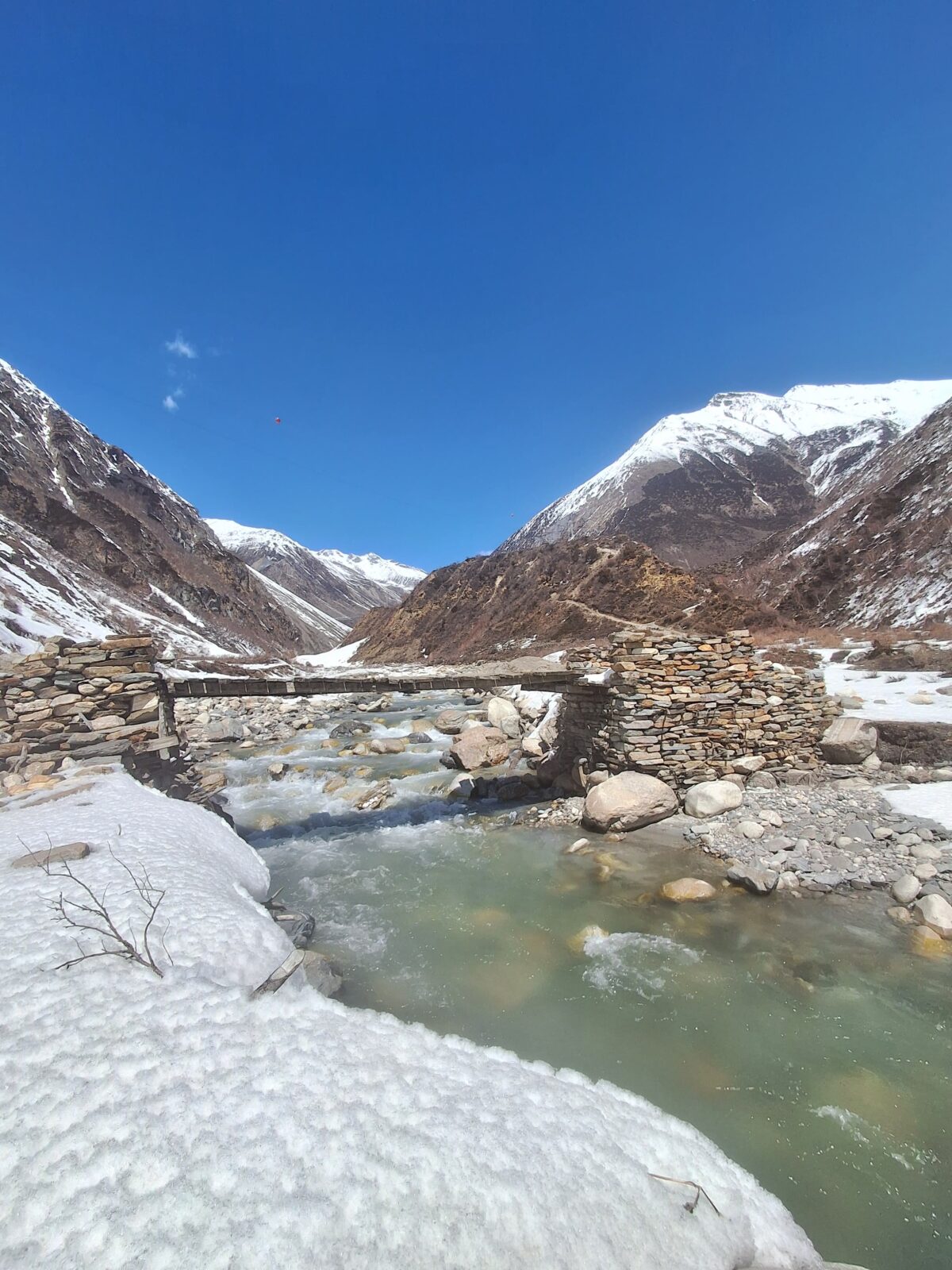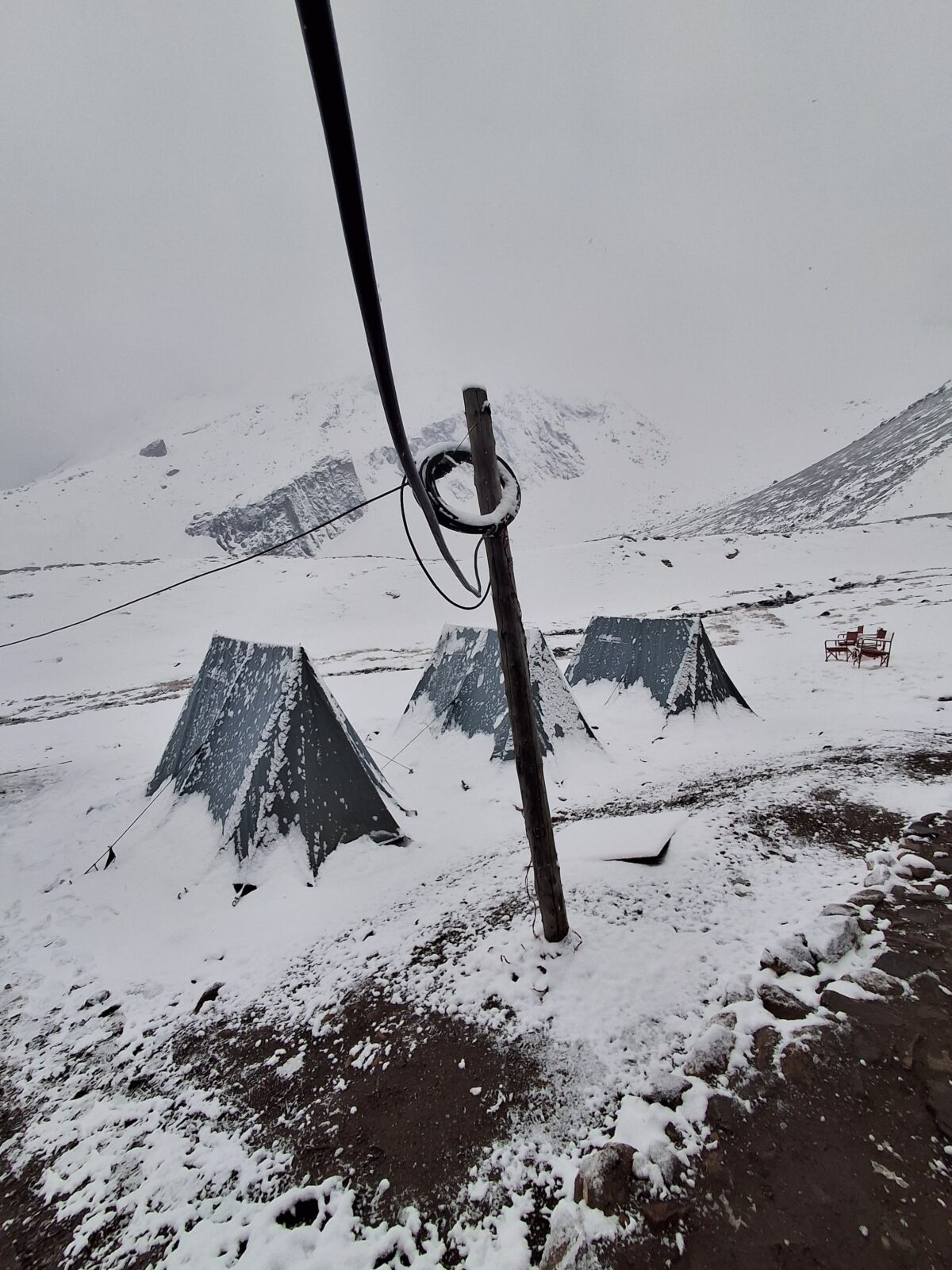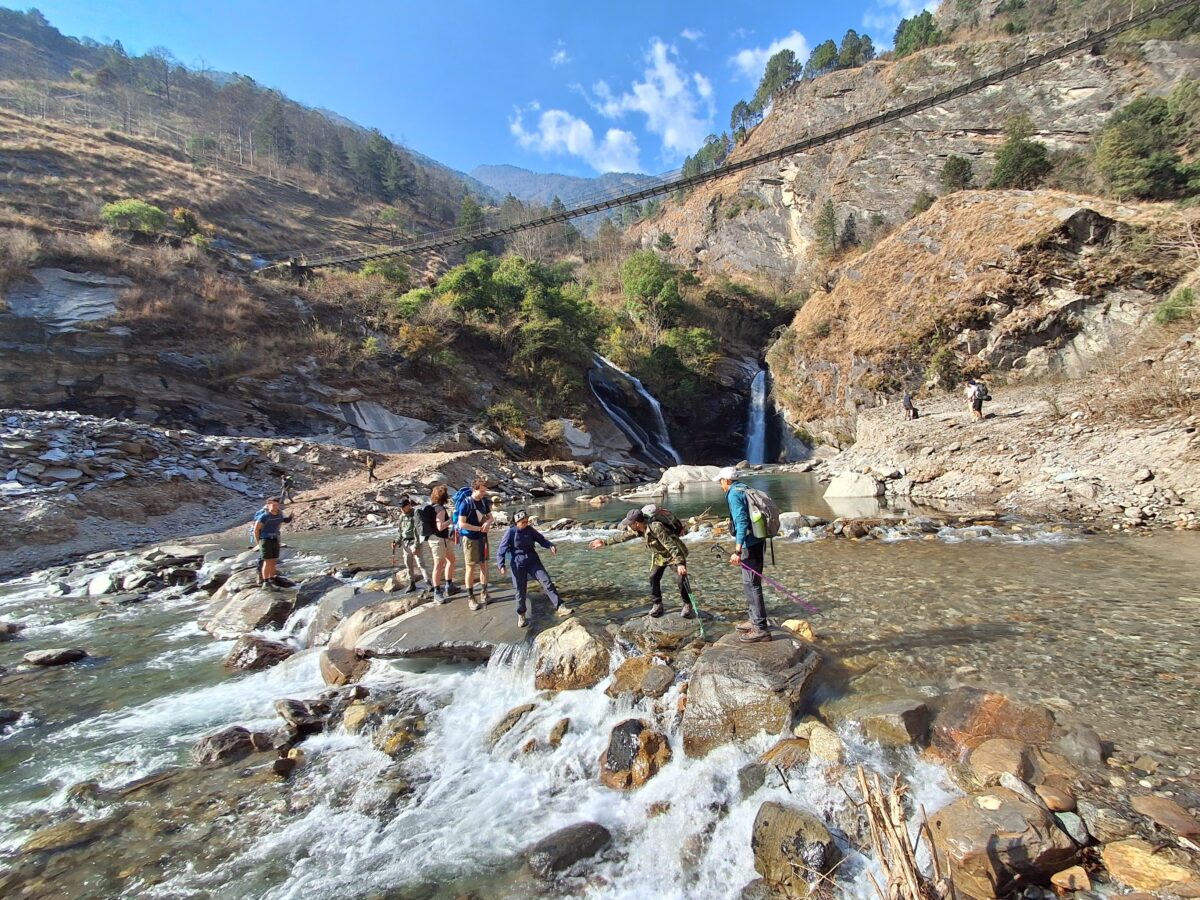Manaslu Circuit Trek Difficulty
Manaslu Circuit Trek reaches altitudes of over 5,000 meters, with the highest point being the Larkya La Pass at an elevation of 5,160 meters. Trekking at such high altitudes can be physically demanding and increase the risk of altitude sickness, which can be debilitating if not properly managed.
The terrain along the Manaslu Circuit is rugged and varied, consisting of steep ascents, rocky trails, glacial moraines, and high mountain passes. This can be particularly challenging, requiring good stamina, balance, and hiking experience. The trek also involves crossing high passes, which can be strenuous and demanding, even for seasoned trekkers.
Additionally, the Manaslu region is extremely remote and isolated, with limited infrastructure and facilities along the trail. This means that you must be prepared for emergencies, as access to medical assistance or evacuation can be challenging in unforeseen circumstances.
Weather conditions in the Manaslu region can also be unpredictable, with extreme cold, strong winds, and snowfall potential, especially during the colder months. Proper gear and preparation for these conditions are essential for your safety and comfort.
Despite these challenges, the Manaslu Circuit Trek offers breathtaking mountain vistas, diverse landscapes, and the opportunity to experience the region’s traditional Tibetan culture. The challenges can be managed effectively with proper preparation, acclimatization, and the guidance of experienced trekking guides and porters.
As a reputable trekking agency, we strongly recommend hiring a qualified guide and porter for the Manaslu Circuit Trek. Our guides are experienced professionals who can assist with navigation, acclimatization, and ensuring your safety throughout the trek. Porters can also alleviate the burden of heavy loads, allowing you to conserve energy for the demanding trek.
At Manaslu Trek Nepal, we understand you’re considering the Manaslu Circuit trek – a truly magnificent adventure in the heart of the Himalayas. It’s no surprise you’re curious about the difficulty! Here’s a breakdown to help you decide if this trek fits your fitness level perfectly.
Rugged Terrain:

Don’t be fooled by the average trekking time of 6-8 hours. The Manaslu Circuit’s remote and rugged nature can add hours to your day easily. The trail, especially after leaving Jagat village, demands a slower pace. Expect steep ascents, narrow paths clinging to hillsides, and potential rock scrambling. Around Bimtang, the challenge intensifies as you cross glacial moraines – a mix of loose rock, boulders, and sometimes treacherous ice.
The ultimate test on the Manaslu Circuit is the Larkya La Pass. The ascent involves a strenuous climb over potentially loose rock and slippery scree. Be prepared for the descent, which can be even more tricky with potential ice and snowfields. This trek demands focus, surefootedness, and an acceptance that the terrain, not the clock, dictates your progress.
As you approach higher altitudes after Samagaun, the trail traverses over glacial moraines, which are ridges of rocky debris left behind by retreating glaciers. These sections can be unstable and require careful navigation, as the terrain is often loose and uneven.
River crossings:

The Manaslu Circuit trek features various river crossings ranging from sturdy suspension bridges to seasonal log bridges and even direct stream fords. The timing of your trek influences the difficulty, with the monsoon season bringing higher, more challenging crossings.
Expect to cross the Budi Gandaki River multiple times, as well as smaller streams and potentially glacial meltwater near villages like Deng and Bimtang. Your guides will prioritize your safety, and the thrill of river crossings adds an adventurous element to this remarkable Himalayan trek.
Unpredictable Weather

- The Influence of High Elevation: Be ready for swift weather changes, especially above 3000m. A sunny morning can quickly turn into a hailstorm, particularly near passes. Pack adaptable clothing layers—waterproof outerwear, warm mid-layers, and quick-drying base layers—to adapt to these fluctuations. The afternoon tends to be the peak time for such changes, so always carry rain gear and an extra warm layer, even if the forecast looks promising.
- Lingering Monsoon Effects: While trekking outside the monsoon season (June-September) is recommended, some valleys can experience lingering afternoon rains or mists, making the trails muddy and slippery. Be prepared for a mix of weather conditions, even during shoulder seasons.
- Wind Exposure and Chilling Winds: Ridgelines, high passes, and exposed areas are prone to strong, cold winds. These winds can significantly increase the feeling of coldness, even when temperatures aren’t extreme. Windproof layers like jackets and wind pants are crucial to prevent heat loss. Pack hats and gloves for additional protection in exposed sections. Sudden temperature drops often accompany strong winds, so be ready to layer up quickly to avoid getting chilled.
Remote Region
The Manaslu Circuit trek offers stunning Himalayan vistas and a true sense of adventure, but it’s important to understand the challenges that come with venturing into a remote region. Manaslu remains less trodden than popular treks such as Everest Base Camp or Annapurna Circuit.
It attracts trekkers who seek a more secluded and authentic experience. The Manaslu Circuit offers fewer creature comforts. Tea houses are your primary accommodation, providing basic but comfortable rooms and meals. Don’t expect extensive shops or readily available supplies – pack everything you need for the duration of the trek.
Crossing Larke Pass:

Crossing the Larkya La Pass is undoubtedly one of the most challenging and exhilarating experiences of the Manaslu Trek in Nepal. Situated at over 5,000 meters, this formidable mountain pass presents trekkers with physical and mental obstacles to overcome.
Landslide Prone Area in Manaslu
The monsoon season (June to September) significantly increases the risk of landslides due to heavy rainfall and saturated ground. The Himalayas are geologically active, and landslides can occur in several areas along the Manaslu Circuit. Weather conditions, erosion, and seismic activity can all trigger landslides. Some sections of the manaslu trek is historically known for higher landslide risk, but this can change over time with trail maintenance or unexpected geological events.
Trails between Jagat and Dharapani, especially those clinging to hillsides around the Budi Gandaki gorge, can be prone to rockfall and landslides, particularly after heavy rainfall. Depending on seasonal conditions, the glacial moraines and slopes in this area can be unstable. While not as frequent, sections near the approach and descent of passes like Larkya La can experience slides, especially in icy conditions.
Seasonal Difficulty Variations
| Month | Max Temp (°C) | Min Temp (°C) | Rainfall | Precipitation | Notes |
|---|---|---|---|---|---|
| January-February | 10-15 | Below 0 | Very Low | Snow (especially higher elevations) | Cold, clear skies possible, windy |
| March-April | 15-20 | 0-5 | Low | Occasional Snow (higher elevations) | Pleasant trekking conditions |
| May | 20-25 | 5-10 | Medium | Rain/Snow (higher elevations) | Transition to monsoon, more humidity |
| June-August | 15-20 | 10-15 | High | Monsoon Rains | Muddy trails, landslides, reduced visibility |
| September-October | 15-20 | 0-5 | Low | Occasional Rain/Snow (higher elevations) | Excellent trekking, clear views |
| November-December | 10-15 | -5 to 0 | Very Low | Snow (especially higher elevations) | Cold, potential for snow on trails |
While the core challenges of the Manaslu Circuit trek remain constant, the season you choose significantly influences the difficulty of your experience. Here’s how weather and trail conditions change throughout the year:
Spring (March-May)
Spring offers generally favorable conditions for trekking the Manaslu Circuit, making it a popular choice with moderate difficulty overall. Expect clear skies and comfortable temperatures for daytime hiking. However, some challenges remain – peak season can mean busy trails, and higher passes may still have some residual snow from winter.
Monsoon (June-September)
The Manaslu Circuit becomes a very challenging trek during the monsoon season. Heavy rains transform trails into slippery, muddy routes, while the risk of landslides increases significantly. Leeches can be a nuisance, and potential flight disruptions add a logistical challenge. Only the most seasoned adventurers with a high tolerance for difficult conditions should consider trekking during this period, and the lush landscapes offer a unique reward.
Autumn (September-November)
Autumn is considered an ideal trekking season for the Manaslu Circuit. Excellent weather generally prevails, providing clear mountain views and comfortable hiking temperatures. The major challenge during this time can be the popularity of the trek, with trails becoming busier. Colder nights become more likely as the season progresses, so be prepared with warm layers.
Winter (December-February)
Winter trekking on the Manaslu Circuit becomes an extreme experience. Expect very cold conditions and the potential for heavy snowfall that might make sections of the trek, especially high passes, impassable. Limited teahouse availability adds to the logistical challenge. The unique winter wonderland scenery and solitude might entice highly experienced trekkers. However, proper specialized gear and thorough preparation are absolutely essential.
Elevation Variation in Manaslu Circuit Trek

The Manaslu Circuit trek presents a significant challenge with its dramatic elevation variation. Starting at approximately 700m in Soti Khola, you’ll traverse a diverse range of altitudes as you ascend towards the trek’s highlights – Larkya La Pass (5160m/16,929 ft) and Thorong La Pass (5,416m/17,769 ft). Along the trek, you’ll stay in villages like Lho (3,180m/10,433 ft) and Samagaon (3,530m/11,581 ft), which allow your body to adjust to the increasing elevation gradually.
Be prepared for tough climbs and the effects of higher altitudes on your body. A carefully designed itinerary with acclimatization days is crucial to avoid altitude sickness. Staying hydrated, listening to your body, training beforehand, and dressing in layers will contribute to your success and enjoyment as you conquer the elevation challenges of the beautiful Manaslu Circuit trek.
| Day | Location | Approx. Elevation (meters) | Approx. Elevation (feet) | Elevation Change (meters) | Elevation Change (feet) |
|---|---|---|---|---|---|
| 1 | Machha Khola | 900 | 2,953 | + 0 (Start) | + 0 (Start) |
| 2 | Jagat | 1340 | 4,396 | + 440 | + 1,443 |
| 3 | Deng | 1860 | 6,102 | + 520 | + 1,706 |
| 4 | Namrung | 2630 | 8,629 | + 770 | + 2,526 |
| 5 | Lho | 3180 | 10,433 | + 550 | + 1,804 |
| 6 | Samagaon | 3530 | 11,581 | + 350 | + 1,148 |
| 7 | Acclimatization – Samagaon | 3530 | 11,581 | + 0 | + 0 |
| 8 | Samdo | 3860 | 12,664 | + 330 | + 1,083 |
| 9 | Acclimatization – Samdo | 3860 | 12,664 | + 0 | + 0 |
| 10 | Dharmasala | 4460 | 14,632 | + 600 | + 1,969 |
| 11 | Larkya La Pass | 5160 | 16,929 | + 700 | + 2,297 |
| 11 | Bimthang | 3720 | 12,205 | – 1440 | – 4,724 |
| 12 | Dharapani | 1860 | 6,102 | – 1860 | – 6,099 |
How to prepare for the Manaslu Circuit Trek?

Proper fitness, trekking experience, and mental fortitude are crucial for taking on this challenging multi-day trek in the Himalayas. Here are some additional details to expand on your points:
Fitness is Key:
- Cardio: Aim for 3-4 weekly cardio sessions, building up to 60-90 minutes of sustained effort like running, cycling, or swimming. This will build the aerobic base needed for trekking at high altitudes.
- Strength Training: To strengthen your lower body, focus on leg exercises like squats, lunges, and calf raises. Core exercises like planks and crunches help balance and carry a heavy pack.
- Hiking: Start training hikes 2-3 months before your trek, gradually increasing the distance, elevation gain, and pack weight to simulate trek conditions.
Prior Trekking Experience:
- If you haven’t done multi-day treks before, consider tackling some shorter 2- to 3-day hikes first to get used to the routine of camping, carrying a pack, and experiencing altitudes above 3,000-4,000m /9,842 ft – 13,123 ft benefits the Manaslu Circuit, which goes above 5,000m/ 16,404 ft. It is not an issue if you can’t hike at that height in your home country.
Embarking on the Manaslu Circuit Trek promises an unforgettable adventure amidst the breathtaking landscapes of the Himalayas. However, tackling this iconic route comes with its challenges, and investing in quality gear is paramount to ensuring a safe and enjoyable journey.
Have a Proper Gear
One of the first items on your checklist should be a comfortable, well-fitting backpack. Considering the rugged terrain and the long hours spent trekking, a sturdy backpack specifically designed for the demands of the Manaslu Circuit Trek is essential. Look for features like ample padding, adjustable straps, and a supportive frame to alleviate the strain on your shoulders and back as you navigate the trail’s ups and downs.
Equally crucial are your hiking boots. The rocky paths, steep ascents, and unpredictable terrain of the Manaslu Circuit demand footwear that offers both stability and protection. Opt for sturdy hiking boots with excellent ankle support and grippy soles to ensure stability on uneven surfaces. Investing in quality boots will enhance your comfort and reduce the risk of injuries along the way.
Layering is key when it comes to dressing for the varying weather conditions encountered on the Manaslu Circuit Trek. Start with moisture-wicking base layers to keep sweat at bay, followed by insulating mid-layers to trap heat close to your body. A waterproof and windproof outer shell is essential for shielding you from rain, snow, and chilly winds at higher elevations. By investing in a proper layering system, you’ll stay comfortable and prepared for whatever weather challenges the trek may throw your way.
Packing smart is another crucial aspect of preparing for the Manaslu Circuit Trek. With limited space in your backpack, prioritize essentials and aim to minimize unnecessary weight. Consult with experts at Manaslu Trek Nepal for personalized gear recommendations tailored to the specific demands of this challenging trek. Their expertise will ensure that you’re equipped with the right gear to tackle the varying terrain and weather conditions encountered along the way.
Finally, don’t forget to pack essential items to keep you protected from the elements. Rain gear, including a waterproof jacket and pants, is indispensable for staying dry during sudden downpours or snowfall. Warm layers, gloves, and a hat are essential for combating cold temperatures, particularly when crossing high mountain passes like the formidable Larkya La Pass. Sun protection, including sunglasses and sunscreen, is also essential for shielding your skin and eyes from the intense Himalayan sun at higher altitudes.
By investing in quality gear, packing smart, and preparing for the unique challenges of the Manaslu Circuit Trek, you’ll set yourself up for a rewarding and memorable adventure in the heart of the Himalayas. With the right equipment and mindset, you’ll conquer the trail’s difficulties and emerge with a sense of accomplishment and awe-inspiring memories to last a lifetime.
Consider Hiring a Porter
Hiring a porter for the Manaslu Circuit Trek is highly recommended due to the trek’s difficulty level and the challenges posed by the rugged terrain and high altitudes. The Manaslu Circuit Trek involves carrying a heavy backpack for multiple days, which can be extremely taxing, especially when combined with the challenging terrain and high altitudes. A porter can carry a significant portion of your load, reducing the physical strain on your body and allowing you to conserve energy for the demanding trekking days.
While on the Manaslu Circuit trek
Listen to Your Guide:
Your guides from Manaslu Trek Nepal are seasoned experts who prioritize your safety above all else. Throughout the trek, heed their advice and follow their instructions diligently, especially when it comes to pacing yourself and acclimatizing to the altitude. They possess invaluable knowledge of the terrain, weather conditions, and potential hazards, making them indispensable allies on your trekking journey.
Hydrate and Fuel:
Staying hydrated and properly fueled is essential for maintaining energy levels throughout the trek. Drink plenty of water and electrolyte-rich fluids to combat the effects of high altitude and physical exertion. Additionally, indulge in small, frequent snacks to replenish your energy stores and keep fatigue at bay. Manaslu Trek Nepal can provide guidance on suitable snacks and hydration strategies tailored to the demands of the Manaslu Trek.
Pace Yourself:
As you ascend through the breathtaking landscapes of the Manaslu region, remember that it’s not a race to the finish line, especially at higher altitudes where the air is thinner. Find a sustainable rhythm that allows you to maintain a steady pace without overexerting yourself. Take breaks as needed to catch your breath, soak in the scenery, and appreciate your momentous journey.
Communicate:
Effective communication is key to ensuring your well-being and the success of your Manaslu Trek. Be open and honest with your guide and fellow trekkers about how you feel physically and mentally throughout the journey. If you experience any symptoms of altitude sickness or struggle with the terrain, don’t hesitate to voice your concerns. Your guides and fellow trekkers are there to support you every step of the way.
Stay Positive:
Embrace the challenges that come with trekking in the Himalayas, knowing that the stunning scenery and sense of accomplishment will more than reward your efforts. Maintain a positive attitude, even when faced with adversity, and draw inspiration from the majestic beauty of the Manaslu region. With determination, resilience, and the unwavering support of Manaslu Trek Nepal, your Manaslu Trek will be an unforgettable journey of a lifetime.
By incorporating these essential tips into your Manaslu Trek adventure with Manaslu Trek Nepal, you’ll not only navigate the difficulties of the trek with confidence but also forge unforgettable memories and experiences that will stay with you long after the journey’s end.